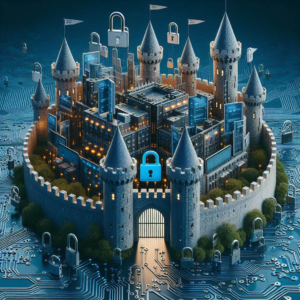From Passwords to Fortresses: Your Essential Guide to Cybersecurity
Fortifying Your Digital Fortress: A Comprehensive Guide to Unbeatable Cybersecurity
 Embarking on the quest for unbeatable password security demands more than just technical jargon – it requires a comprehensive and evolving strategy. In this guide, we go beyond the basics to provide you with a holistic approach to fortify your digital identity against the ever-evolving tide of cyber threats. Join us on this transformative journey that amalgamates innovation with usability, creating a robust and user-friendly defense.
Embarking on the quest for unbeatable password security demands more than just technical jargon – it requires a comprehensive and evolving strategy. In this guide, we go beyond the basics to provide you with a holistic approach to fortify your digital identity against the ever-evolving tide of cyber threats. Join us on this transformative journey that amalgamates innovation with usability, creating a robust and user-friendly defense.
Mastering the Art of Passphrases:
Instead of grappling with complex combinations of characters, embrace passphrases. Create memorable sentences or combinations of words, incorporating symbols and varying cases. For example, “Coffee@Sunrise$OnMars” is both complex and easily memorable. However, even the most creative passphrase can be vulnerable if reused across multiple accounts. Learn more about mastering the art of passphrases here.
The Power of Multi-Factor Authentication (MFA):
Transform your security landscape with Multi-Factor Authentication (MFA), going beyond the conventional 2FA. MFA isn’t merely an additional step; it’s a formidable barrier. Popular apps like Google Authenticator or Authy sync seamlessly with your accounts, providing an extra layer of protection beyond your passwords. Choose apps with strong reputations and secure practices. Explore a comparison of popular 2FA apps and their features here.
Password Managers: Your Digital Sentry:
Bid farewell to the era of forgotten passwords and repetitive combinations. Integrate a reliable password manager like LastPass, 1Password, or Bitwarden into your routine. These tools generate and store complex passwords using robust encryption, reducing the cognitive load of remembering multiple credentials. The master password for your password manager acts as the gatekeeper to your digital vault. Choose it wisely, using a combination of upper and lowercase letters, numbers, and symbols, exceeding at least 16 characters in length. While LastPass, 1Password, and Bitwarden offer robust encryption, the key truly lies in your master password. Treat it with the utmost importance. Keep your password manager app updated for the latest security patches and features.
Frequent Password Updates with a Twist:
Break free from the monotony of routine password changes by adding a twist. Sync your password changes with significant events – birthdays, anniversaries, or other memorable occasions. This ensures regular updates without the burden of an arbitrary schedule. Avoid using easily guessable personal information within your passphrases.
Phishing Awareness and Education:
Arm yourself against the crafty exploits of phishing attacks. Regularly educate yourself on the latest tactics employed by cybercriminals. Exercise caution when clicking on links or providing sensitive information, even if seemingly legitimate. Remember, no legitimate company will pressure you to urgently update your information or click on suspicious links.
Device Lockdown and Biometric Authentication:
Extend your fortress to the physical realm. Enable device lockdown features such as fingerprint or facial recognition on your smartphones and laptops. This not only safeguards your device but also acts as an additional layer of defense for your accounts. Be aware that biometric authentication methods can also have vulnerabilities, so consider them as part of a layered security approach.
Personalized Security Questions:
Enhance your security posture with personalized security questions. Customize them to your experiences. For example, “What was the name of your first pet’s favorite toy?” adds an extra layer of complexity to the authentication process. Avoid using answers that can be easily found online through social media or other public sources.
Security Hygiene Checklists:
Craft a personalized security hygiene checklist. Regularly review your security settings, update software (including your password manager app!), and audit your accounts. By establishing a routine, you ensure that your digital armor remains polished and resilient against emerging threats. Include checking for data breaches and compromised passwords on sites like Have I Been Pwned? in your routine.
Additional Tips and Considerations:
- Incident Response Plan: Develop an incident response plan outlining the steps to be taken in case of a security breach.
- Secure Email Practices: Emphasize secure email practices, such as being cautious with email attachments and links.
- Network Security: Extend your focus to network security. Ensure that your home or office network is secure by using strong passwords for Wi-Fi, regularly updating router firmware, and considering the use of a virtual private network (VPN).
- Secure Disposal of Devices: When retiring old devices, ensure secure data disposal. Use reputable methods to wipe data thoroughly from devices before discarding or selling them.
- Zero Trust Security Model: Consider adopting a Zero Trust security model, where no one is trusted by default, even those inside the network perimeter.
- Secure Cloud Practices: If you use cloud services, apply security best practices. Enable two-factor authentication for cloud accounts, regularly review and update access permissions, and encrypt sensitive data before storing it in the cloud.
- Employee Training and Policies: In a workplace setting, ensure that employees are well-trained on security policies and best practices.
- Physical Security Measures: Don’t overlook physical security. Ensure that your devices are physically secure, especially mobile devices.
- Regular Security Audits and Penetration Testing: Conduct regular security audits and consider periodic penetration testing to identify and address potential vulnerabilities.
- Stay Informed about Emerging Threats: Keep yourself informed about the latest cybersecurity threats and trends.
- Device and Software Updates: Regularly update your devices and software to patch vulnerabilities.
Remember, cybersecurity is an ongoing process, and a combination of proactive measures, awareness, and adaptability is key to maintaining a strong defense against evolving threats.
